Reimagine human potential in the generative AI era
The power of generative AI is only as strong as people’s willingness to use it. Too often, organizations are solely focused on how generative AI can simplify and automate today’s processes—many of them routine and mundane. While such measures may increase productivity, executives are overlooking a rare opportunity to revolutionize employee potential and pioneer a new future for their organization.
It’s a future of work that encompasses the evolving landscape of work, shaped by changing workforce expectations, new workplace practices, and advancements in technology, especially AI and automation.
That’s why organizations need to first envision the technology not as a standalone, but within the context of their workforce. How can generative AI help organizations reimagine job roles that will drive improved outcomes and enhanced business value? For starters, it can be used to help reveal untapped potential and reinvent workflows. And leveraged strategically—using the technology to integrate systems, data, and people across business functions— generative AI can help bolster a future of work strategy, and even forecast employee potential.
Organizations need to first envision gen AI not as a standalone, but within the context of their workforce.
In partnership with Oracle, the IBM Institute for Business Value (IBM IBV) interviewed 1,000 C-suite executives across 20 countries and 20 industries. We asked executives to share insights about their plans, actions, and aspirations for realizing their future of work strategy.
How are they integrating technology, adapting workforce practices, and enhancing employee experiences to drive innovation?
One visionary group of executives is focused on boosting engagement, skills development, and bottom-line business results. These visionaries are betting big on their future, with actions and investments that can make a difference to their bottom line.
Visionaries project strong financial outcomes, with 27% expecting their future of work strategy to generate additional ROI today. 43% anticipate additional ROI by 2026. And to date, in these early phases of generative AI adoption, they are reporting 35% more overall profitability relative to their competition.
Change is not easy. Our latest CEO research shows that a resistance to change among employees is one of the top three barriers to innovation. A culture that espouses “failing forward” goes a long way toward dissolving that resistance. A culture that encourages risk-taking—in effect, destigmatizing it—becomes more than a place of employment; it becomes an environment of experimentation, learning, and fulfilled potential.
A culture that creates rewarding collaborations between its people and generative AI is the future of work.

Part 1.
An invitation to reimagine the future of work
In the context of the future of work, employee potential encompasses not just their current skills and performance, but also their aptitude for acquiring new skills, taking on more complex responsibilities, and contributing to an organization’s long-term success.
This requires exploration and the courage to reinvent—not just repurpose—current ways of working and processes. What will the skills of tomorrow look like? How does an organization define them, quantify them, and prepare for them?
The very idea of potential is exciting, both to employees and management. Yet when AI and automation—with all their uncertainties—are prime catalysts, “untapped” potential can sometimes turn to “uh oh.” 87% of executives expect job roles to be augmented, rather than replaced, by generative AI.2 Everyone is wondering what the new big picture will look like, and they’re anxious about what it means for them.
This big picture is an elusive target, because the generative AI applications that could deliver the greatest value tomorrow have yet to be discovered. But the organizations that build a solid, skills-focused foundation for generative AI today can pivot and build momentum as new opportunities arise.3
What will the skills of tomorrow look like? How does an organization define them, quantify them, and prepare for them?
Visionary—or vertigo?
Forging ahead in this brave new world without a strategy is like driving across a continent with no GPS. But right now, there’s not much progress on future of work approaches.
According to our research, fewer than half (45%) of executives have a vision for the future of work and have forecasted the impact on employees. And transparency in the workplace is suffering. Only half of organizations with a vision in place or working toward a vision have shared the details with their people.
Organizations that don’t forecast employee impact also don’t share straight talk with their employees about AI, automation, and the impact on their career and skills development.

In contrast, 80% of visionary organizations have a clear plan for the future of work and have forecasted employee impact. 76% have articulated the vision to their people. For all levels of employees, virtually 100% of organizations surveyed deemed at least some level of impact from these technologies. AI and automation are here to stay—no one can hide and still thrive in their career.
Only one out of two employees are getting straight talk about AI, automation, and the impact on their career and skills development.
HR executives, here’s your opportunity
Almost all of our executives (93%) say HR plays at least some role in developing an organization’s future of work strategy, yet is it enough? One in five (20%) say HR actually owns the strategy in their organization, and 74% report HR either supports the strategy or is one of many key players. If HR does not own the future of work strategy, who will?
HR has an opportunity to champion a generative AI-friendly culture, empowering managers to motivate their employees to embrace this new technology and use generative AI itself to power the very tools that promote it. Organizationally, HR can encourage collaboration, experimentation, and the co-creation of new jobs and ways of working. And within HR, they can adopt use cases that drive efficiency and improve the employee experience.4 In fact, other IBM IBV research shows organizations that deliver top employee experiences overall outperform on revenue growth 31% more than others.5
One caveat: automating bad processes won’t make them better. To deliver real productivity gains, organizations must break tasks down to their essential elements. For HR, it takes defining use cases with precision and imagination, both of which can be driven with the help of AI.
One caveat: automating bad processes won’t make them better. To deliver real productivity gains, organizations must break tasks down to their essential elements.
AI on the upswing in specific HR domains
AI-powered tools are helping organizations streamline processes, reduce bias, and make integrated data driven decisions. But the AI aperture is expanding beyond cut-and-dry business decisions. According to our executives, today’s priorities are front-line facing and employee centric—requiring data and insights to be democratized. In fact, 64% of our visionaries report data-driven decision-making is pervasive in many areas or across their organization.
Organizations are increasingly framing AI strategies that extend beyond mere command and control and process steps. HR can help their leaders and managers use AI to empower people to unlock their performance and potential, connecting them to what matters most for their job and their personal goals. This is a chance to further humanize work. AI tools and data can help provide clarity on work roles and expectations; guide and coach employee development with purpose; and help foster employee progression and internal career mobility. It’s about giving people the autonomy to flex, grow, and adapt their work to a changing technology environment, quickly and intelligently.
Adoption of talent use cases—increases from today to 2026
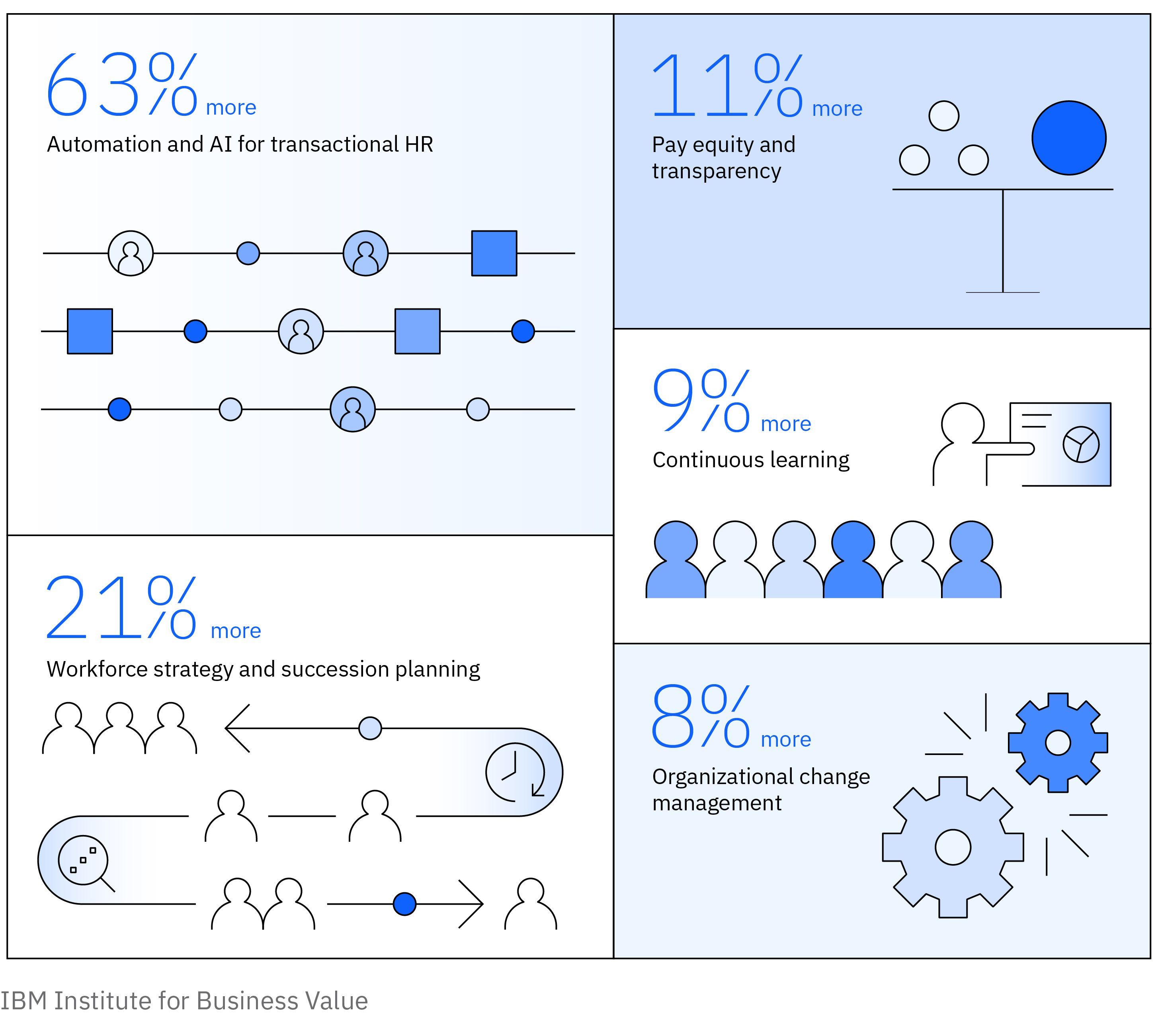
Q. In which of the above talent use cases has your organization adopted AI in 2024? In 2026?
Translating successful use case experimentation into business value at scale is a journey—and how much experience an organization has with AI influences where to start.6 Our executives expect to double down on foundational use case adoption in the HR arena—including automation and AI for transactional HR—with an expected 63% increase from today to 2026. Executives indicate they are investing in business processes to elevate employee experience, in direct response to evolving workplace expectations and motivations. They are prioritizing workflows for career growth, pay transparency, continuous learning, and organizational change management by 2026. And they’re making these moves with assurance. Nearly 60% of executives are confident they can scale these AI activities across their enterprise over the next two years. | 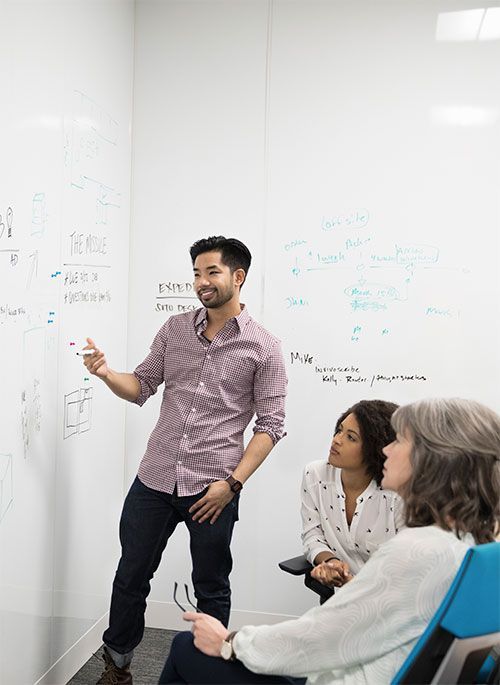 |
Across HR functions, five times more organizations that have implemented AI end-to-end with an IT strategy that merges AI, cloud, and application modernization have achieved positive ROI compared to other organizations.7
It’s about giving people the autonomy to flex, grow, and adapt their work to a changing technology environment, quickly and intelligently.
Orchestrating technology impact
Executives overwhelmingly understand the stakes: the impact of technology—specifically on the future of work for employees—is existential. Yet to date, only 42% of executives say their organization is integrating technology across business functions in many areas or everywhere. This is a missed opportunity: integration of technology can support seamless access and use of data insights to intelligently scale decision-making with speed. And according to 57% of CEOs, culture change is more important to becoming a data-driven organization than overcoming technical challenges.8
Ultimately, technology integration across disparate parts of the organization is more than just plug and play. The challenge is integrating legacy systems, new applications, and a myriad of other tools to satisfy the needs of stakeholders across the business.
What we’re talking about here is broad-brush, comprehensive technological transformation that will power the future of work strategy, often thinking big but starting small and moving fast with purpose and intention. To truly assess, quantify, and prepare for the impact of technology at a more micro level—at those smaller, more manageable steps that every transformation needs to get off the ground—organizations need to engage their HR function. And they need HR to engage AI, because optimizing AI’s impact will require people, with their curiosity, imagination, and empathy, to collaborate with AI for outcomes neither can achieve alone.
Only 42% of executives say their organization is integrating technology across business functions in many areas or everywhere.

Integrating technology across the enterprise

Q. To what degree is your business integrating technology across functions?
Case study
Transforming the colleague experience at the Phoenix Group.9 The Phoenix Group, the UK’s largest long-term savings and retirement business, aspires to be recognized as the most exceptional workplace for their people by 2026. Their mission is to create fit-for-purpose HR solutions that deliver an awesome experience through appropriate automation, self-service, and process simplification. The intent is to enable efficiencies, fostering opportunities for their people and HR to do high value work, ultimately contributing to business objectives. With that in mind, the Phoenix Group recognized the need to upgrade its HR system to keep up with digital innovations and prepare for the future of work. They moved to an Oracle Cloud HR platform and developed additional enhancements, including Thunderbird, a key enabler to creating rewarding colleague experiences. IBM served in the critical role of systems integrator. Thunderbird was designed to automate HR processes, eliminate unnecessary activity, and simplify processes. The approach was to introduce, optimize, and differentiate this new feature as part of their implementation journey. At its core is Mackenzie, a chatbot that provides on-demand support to employees. Since its go-live, Mackenzie has engaged in over 26,000 interactions, boasting a 93% success resolution rate. The Phoenix Group plans to extend Mackenzie’s capabilities into generative AI, envisioning a future where HR processes can be further optimized and personalized. As the Phoenix Group sails into a digital future, one thing remains clear for the organization: at the heart of innovation is collaboration. Alongside IBM and Oracle, the Phoenix Group is harnessing the power of automation and chatbots to improve their HR function and overall workplace experience. They’re not only preparing for the future of technology—but for the future of work itself. |
Part II.
Forecasting employee potential
How do you plan for a tornado? Accurate forecasting tools and methods are must-haves—just ask your local weatherperson. The same logic applies to the maelstrom of AI and automation.
Envisioning an employee’s future success also requires a broadened perspective. Technical savvy is critical, of course, but so are adaptability, creativity, and the ability to embrace AI and automation as allies. By identifying employee potential to develop and apply these innate skills, organizations can invest in the right talent and develop a flexible, relevant workforce that is fit for the future.

The goal is to anticipate how a person might develop, perform, or contribute in their career and personal life.
Forecasting human potential involves projecting an individual’s future capabilities, achievements, and growth based on various factors. This can include assessing skills, talents, personality traits, experiences, and educational background. The goal is to anticipate how a person might develop, perform, or contribute in their career and personal life. This kind of forecasting often uses data models to make informed predictions about future potential.
Pivoting to potential
Executives have gotten the message: intentionally forecasting employee potential is gaining momentum. Almost three out of four (74%) indicate they’ve defined, managed, or optimized their methods for evaluating employee potential. Visionaries track higher, with 87% advancing their efforts in this area. This shift underscores a growing commitment to moving from a skills-based approach to a comprehensive potential-based approach.
They’re doing this using a range of tools—and most of these tools, not surprisingly, are themselves prime use cases for AI and automation—often setting clear performance metrics to drive cultural change. They include succession planning software, chatbot applications, data analytics platforms, and more. One area for improvement: only 19% of executives overall have succession planning software with predictive capabilities, the evaluation tool considered most important by all executives.
Effective tools—many of which are available via talent management systems—can ease the arduous task of mapping and managing skills across an organization. These tools can democratize skills data and insights, and provide valuable guidance to HR leaders, people managers, and employees themselves. Yet these tools must also be combined with human insights to arrive at more nuanced assessments.
For example, assessments often focus on individual task performance, overlooking broader implications for an organization and its culture. When cultivating talent, it’s important to consider both innate potential and what could be a teachable fit. Giving teachable fit the same emphasis as proven capability can help ensure employees access a range of experiences and opportunities.
Adopting tool usage is not enough. Organizations must cultivate a culture that embraces and rewards personal growth and intentional focus on future potential across the enterprise.
Organizations must cultivate a culture that embraces growth and potential across multiple business practices.
Top 5 tools used to evaluate employee potential
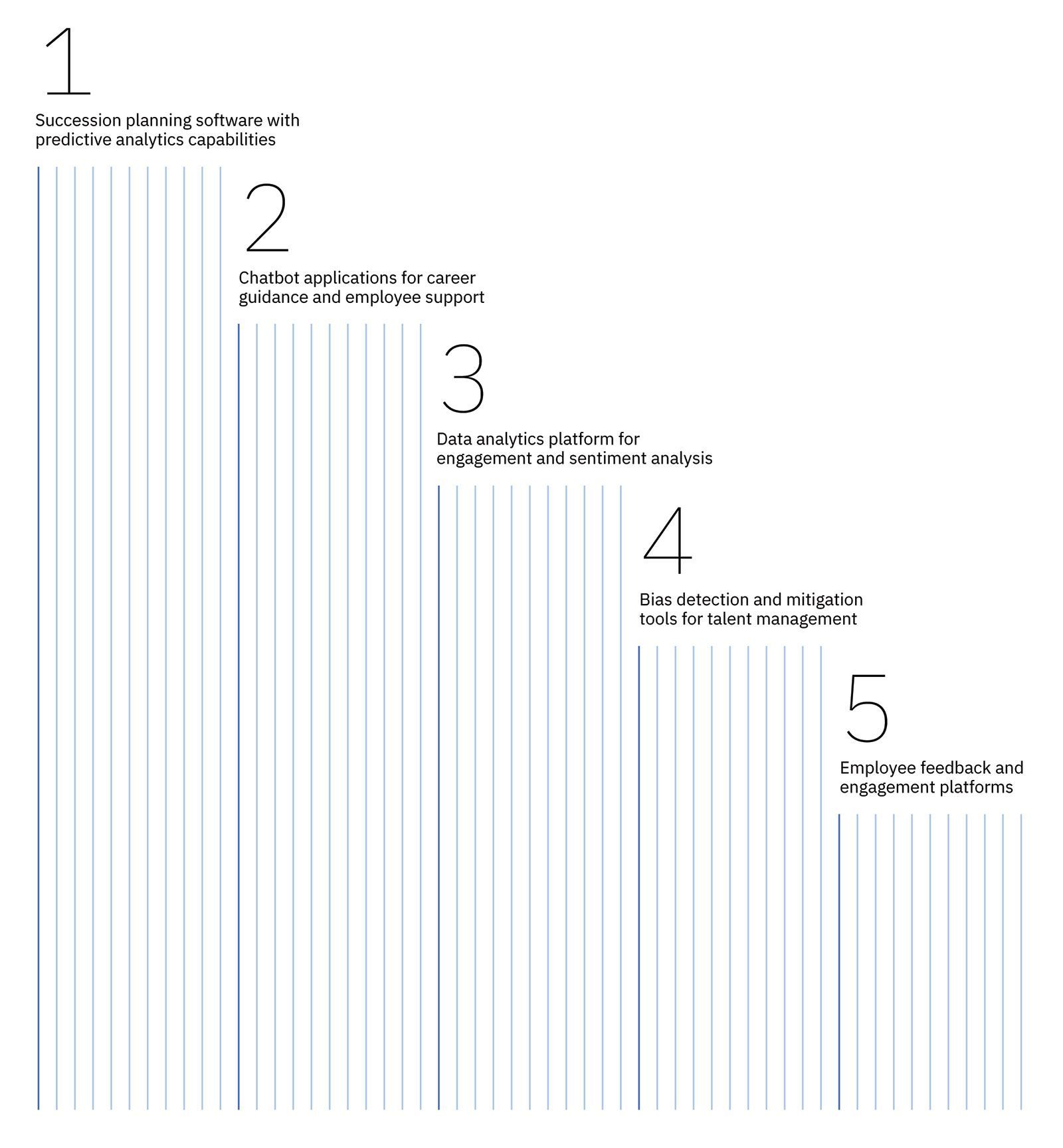
Q. What tools are you using to evaluate employee potential?
You can’t run the enterprise of tomorrow with yesterday’s talent. And you can’t plug tomorrow’s talent into yesterday’s operating model. Organizations must build a flexible structure that allows for evolution.
As organizations forecast the performance potential of employees, they must answer obvious questions, such as what skills and attributes will be valuable going forward? For example, we’re seeing notable upticks in essential capabilities needed to successfully interact with AI, including critical thinking (15% more) and emotional intelligence (18% more) by 2026.
How can these capabilities and others be cultivated as an organization, not just at the individual level? What environment motivates people with the desire to grow and the ability to welcome change throughout their career?
Critical workforce capabilities—increases from today to 2026
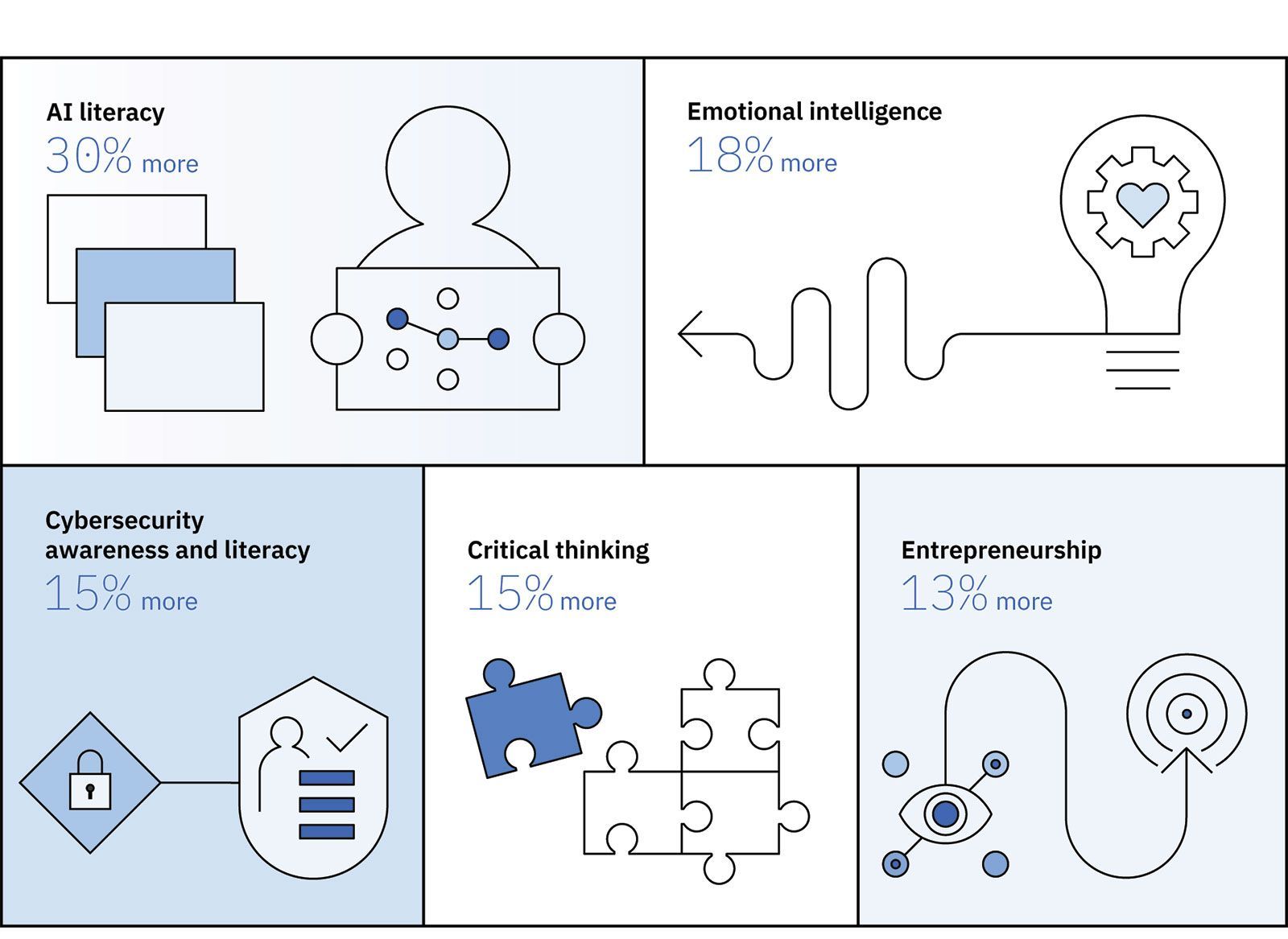
Jumpstarting AI skills development
AI/automation and human collaboration is steadily ratcheting upward—and it’s becoming a business imperative. In 2022, 44% of executives said their organizations empowered people to work in collaboration with AI and automation to a moderate or significant extent. Currently, that figure stands at 65%. In 2026, that’s expected to rise to 78%.
Skills development is the obvious place to start. More than half (62%) of organizations say that a lack of expertise is a barrier to executing their AI and automation strategy to a moderate or significant extent today. That’s expected to drop to 32% by 2026 but still presents a daunting hurdle. However, educating people on how to collaborate with AI can not just help adoption, but can help adoption fuel better business outcomes.
Organizations can create an environment where continuous learning and experience building is the norm. Encouraging risk-taking around the biggest business challenges, exercising gentle rigor, and generously bestowing rewards and recognition can be effective strategies. As well, organizations can look to their employee population for diversity of thought, ages, and backgrounds—all fertile ground for reinforcing employee potential in the future of work.
AI itself can play a huge role here. It can suggest learning, development, and growth opportunities based on the patterns and trends revealed through data-based insights on people, work, roles, and skills. In a sense, AI can be the “connective tissue” between diverse data, analyzing, assessing, and recommending.
Expertise as a barrier to executing an AI and automation strategy
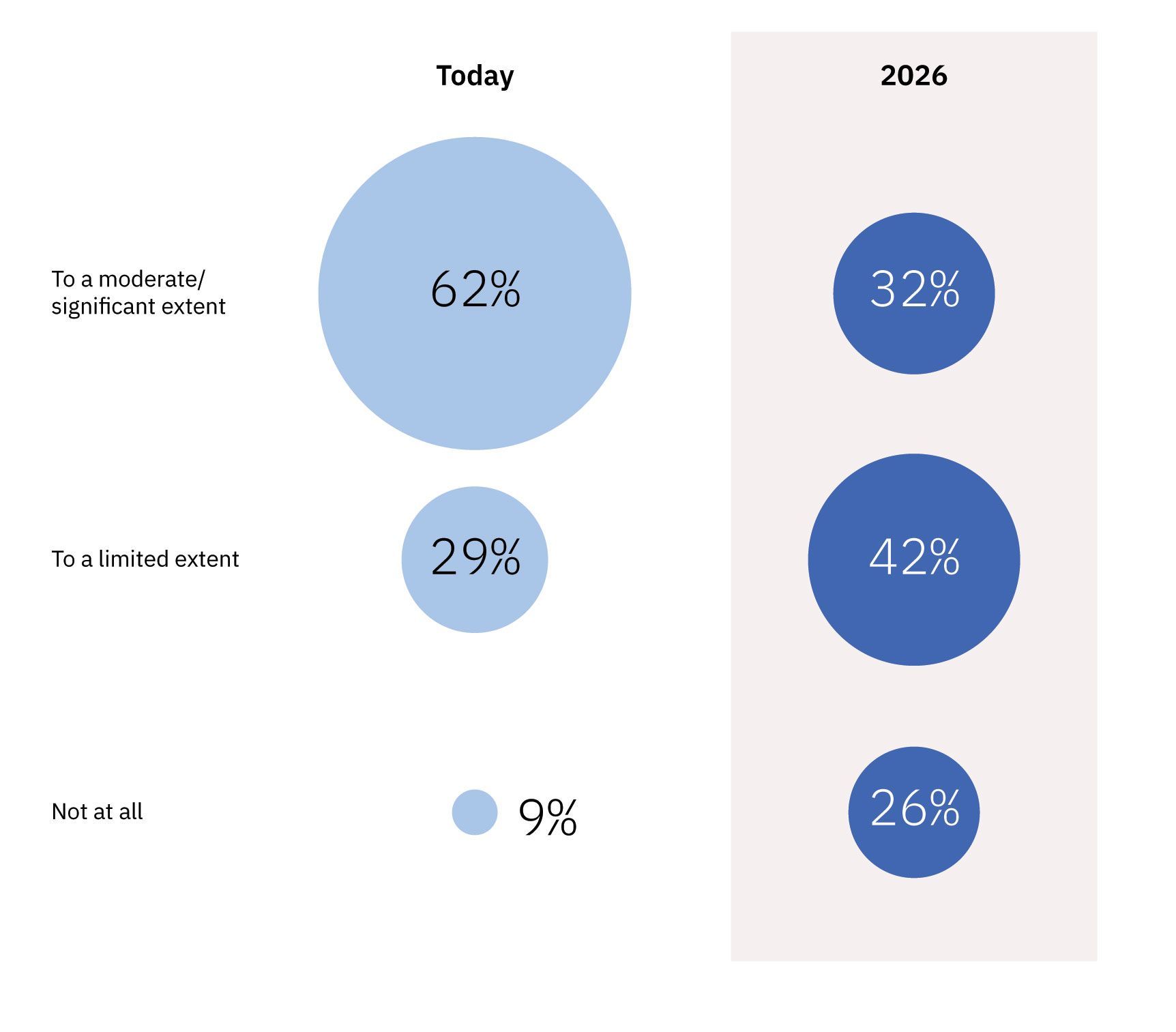
Q. To what extent is lack of expertise a barrier to executing your AI and automation strategy—today and in 2026?
Part III.
Encourage a culture of experimentation
More than half of executives say that in the next three years, generative AI will make entirely new types of work possible.10 It’s all about starting small and moving fast to fail, learn, and scale more quickly.
The biggest gains may come from stepping into the unknown. Collaborating with technology and in-house talent to take managed risks goes a long way toward unlocking potential. In fact, 72% of our visionary group highly encourages risk-taking to explore new ideas.
Still, this encouragement does not always result in a pioneering spirit—at least not yet— as only 54% of visionary organizations report a substantial to great level of innovation and risk-taking.
Innovation, risks, and improvisational thinking lead to breakthroughs, but as in most business cases, some checks and balances are beneficial. For instance, organizations that have an enterprise-wide approach to managing how employees use generative AI say their employee experience investments yield returns that are 46% higher than their peers.11 Yet 63% of organizations do not have a framework for assessing the impact of generative AI on their current workforce.12
Structured approaches, such as design thinking, are an interactive way to ideate and build enthusiasm, and mitigate risks. Organizations can inspire this kind of experimentation through motivational competitions, contests, certification programs, and other recognition.13 And psychological safety is a key point of growth in any healthy organization. IBM IBV research shows organizations that don’t penalize failure achieve a 22% higher rate of revenue growth compared to peers, and that enterprises with an environment of open, fearless innovation show 10% higher revenue growth.14 In other words, guidelines don’t have to be confining—they just help to ensure that AI experimentation doesn’t go haywire.
Think back to your school days and the difference between a lecture hall and an internship. Foundational skills development is important, of course, but rapid experimentation, agile discovery, and boots on the ground can be the best teachers of all.
Action guide
01 Keep the workflow ingredients—but change the recipe.
Get into the weeds of workflow and operating model redesign. Construct workflows that enable agility, while fostering employee well-being and workplace satisfaction. 68% of organizations have expressed disappointment in generative AI investments. And 35% of executives say they are not able to or have not scaled up gen AI initiatives in 2024.15 Going forward, keep essential ingredients of AI—but evolve how they are used.
02 Make AI no big deal.
Focus on integrating AI into daily workflows to position its use as second nature. Consider this: 64% of CEOs say succeeding with AI will depend more on people’s adoption than the technology itself. And already, 51% are hiring for generative AI-related roles that didn’t exist last year.16 It’s not just about automating basic tasks and engineering prompts— it’s elevating existing roles and inventing new ones.
03 Don’t let today’s resumes hold your people back.
Traditionally, about 6% of the workforce has required reskilling. In 2024, that soared to 35% of the workforce—or more than a billion workers globally.17 Your people’s skills and accomplishments to date are already yesterday’s news. A culture of continuous learning, growth, and mobility should be encouraged and rewarded. Focus on potential to tap personal passions and motivators while driving business value at the same time. Emphasize teachable fit for career growth and workplace mobility opportunities.
04 Keep courting your employees.
The generative AI market is poised to grow 46% per year, resulting in a market volume of $356 billion by 2030.18 But people will always be an essential part of your operating model. Entrust employees with autonomy to create their own path forward with AI.
05 Recognize that you don’t know what you don’t know.
78% of business leaders say people often make decisions and then look for the data to justify them.19 It’s time to turn that around. Channel your organization’s data by tapping just-in-time insights on employee sentiment and motivations from engagement tools. Continually align employee direction with the strategic goals of your organization—to the benefit of both.
About IBM and Oracle
For nearly four decades, IBM has been partnering with Oracle to help clients navigate their cloud journeys and maximize their business transformations in a complex hybrid and multicloud world. IBM is a leading hybrid cloud, AI, and consulting services provider helping clients in more than 175 countries capitalize on insights from their data, streamline business processes, and gain the competitive edge in their industries. Oracle offers integrated suites of applications plus secure, autonomous infrastructure in the Oracle Cloud. IBM’s breakthrough innovations in AI, quantum computing, and business services deliver open and flexible options to our clients.
Notes and sources
1. 2024 Global C-Suite Series. 6 hard truths CEOs must face: How to move forward with courage and conviction in the age of AI. IBM Institute for Business Value. May 2024. Unpublished data.
2. Goldstein, Jill, Bill Lobig, Cathy Fillare, and Christopher Nowak. Augmented work for an automated, AI-driven world: Boost performance with human-machine partnerships. IBM Institute for Business Value. August 2023.
3. Goehring, Brian, Manish Goyal, Ritika Gunnar, Anthony Marshall, and Aya Soffer. The ingenuity of generative AI: Unlock productivity and innovation at scale. IBM Institute for Business Value. June 2024.
4. Bowin, David, Andi Britt, Robert Enright, and Dr. Surlina Yin. HR champions generative AI: Embrace experimentation, empower people. IBM Institute for Business Value in partnership with Oracle. March 2024.
5. Adashek, Jonathan, John Granger, Salima Lin, Rob Thomas, Joanne Wright, and Kareem Yusuf. The CEO’s Guide to Generative AI: What you need to know and do to win with transformative technology. IBM Institute for Business Value. 2024.
6. Goehring, Brian, Manish Goyal, Ritika Gunnar, Anthony Marshall, and Aya Soffer. The ingenuity of generative AI: Unlock productivity and innovation at scale. IBM Institute for Business Value. June 2024.
7. IBV Benchmarking AI impact in HR survey. 2024. Unpublished data.
8. 2024 Global C-Suite Series. 6 hard truths CEOs must face: How to move forward with courage and conviction in the age of AI. IBM Institute for Business Value. May 2024. Unpublished data.
9. Briddock, Shána. “The Phoenix Group ignites digital future with HR ‘Thunderbird’ solution.” ERP Today. April 22, 2024.
10. Goehring, Brian, Manish Goyal, Ritika Gunnar, Anthony Marshall, and Aya Soffer. The ingenuity of generative AI: Unlock productivity and innovation at scale. IBM Institute for Business Value. June 2024.
11.2023 IBM Institute for Business Value next-gen design survey. 212 global CxOs. July 2023. Unpublished data
12. The CEO’s guide to generative AI: Customer & employee experience. IBM Institute for Business Value. August 2023.
13. Bowin, David, Andi Britt, Robert Enright, and Dr. Surlina Yin. HR champions generative AI: Embrace experimentation, empower people. IBM Institute for Business Value in partnership with Oracle. March 2024.
14. Payraudeau, Jean-Stéphane, Anthony Marshall, and Jacob Dencik. Extending digital acceleration: Unleashing the business value of technology investments. IBM Institute for Business Value. October 2020
15. IBM Institute for Business Value. Data from AI model optimization pulse survey (n=200). May 2024. Unpublished data.
16. 2024 Global C-Suite Series. 6 hard truths CEOs must face: How to move forward with courage and conviction in the age of AI. IBM Institute for Business Value. May 2024. Unpublished data.
17. Ibid.
18. “Generative AI – Worldwide.” Statistica. Accessed August 14, 2024. https://www.statista.com/outlook/tmo/artificial-intelligence/generative-ai/worldwide
19. “Global Study: 70% of Business Leaders Would Prefer a Robot to Make Their Decisions.” PR Newsire. April 19, 2023. https://www.prnewswire.com/news-releases/global-study-70-of-business-leaders-would-prefer-a-robot-to-make-their-decisions-301799591.html
Meet the authors
Jill Goldstein, Global Managing Partner for Talent Transformation, IBM ConsultingChris Havrilla, Vice President, Product Strategy, Oracle
Chacko Thomas, Americas Oracle Leader, IBM Consulting
Cathy Fillare, Global HR and Talent Transformation Research Leader, IBM Institute for Business Value
Originally published 03 September 2024





